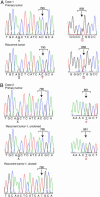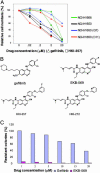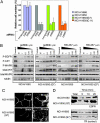Irreversible inhibitors of the EGF receptor may circumvent acquired resistance to gefitinib
- PMID: 15897464
- PMCID: PMC1129023
- DOI: 10.1073/pnas.0502860102
Irreversible inhibitors of the EGF receptor may circumvent acquired resistance to gefitinib
Abstract
Non-small cell lung cancers (NSCLCs) with activating mutations in the kinase domain of the epidermal growth factor receptor (EGFR) demonstrate dramatic, but transient, responses to the reversible tyrosine kinase inhibitors gefitinib (Iressa) and erlotinib (Tarceva). Some recurrent tumors have a common secondary mutation in the EGFR kinase domain, T790M, conferring drug resistance, but in other cases the mechanism underlying acquired resistance is unknown. In studying multiple sites of recurrent NSCLCs, we detected T790M in only a small percentage of tumor cells. To identify additional mechanisms of acquired resistance to gefitinib, we used NSCLC cells harboring an activating EGFR mutation to generate multiple resistant clones in vitro. These drug-resistant cells demonstrate continued dependence on EGFR and ERBB2 signaling for their viability and have not acquired secondary EGFR mutations. However, they display increased internalization of ligand-activated EGFR, consistent with altered receptor trafficking. Although gefitinib-resistant clones are cross-resistant to related anilinoquinazolines, they demonstrate sensitivity to a class of irreversible inhibitors of EGFR. These inhibitors also show effective inhibition of signaling by T790M-mutant EGFR and killing of NSCLC cells with the T790M mutation. Both mechanisms of gefitinib resistance are therefore circumvented by irreversible tyrosine kinase inhibitors. Our findings suggest that one of these, HKI-272, may prove highly effective in the treatment of EGFR-mutant NSCLCs, including tumors that have become resistant to gefitinib or erlotinib.
Figures




Similar articles
-
The T790M "gatekeeper" mutation in EGFR mediates resistance to low concentrations of an irreversible EGFR inhibitor.Mol Cancer Ther. 2008 Apr;7(4):874-9. doi: 10.1158/1535-7163.MCT-07-2387. Mol Cancer Ther. 2008. PMID: 18413800
-
Acquired resistance of lung adenocarcinomas to gefitinib or erlotinib is associated with a second mutation in the EGFR kinase domain.PLoS Med. 2005 Mar;2(3):e73. doi: 10.1371/journal.pmed.0020073. Epub 2005 Feb 22. PLoS Med. 2005. PMID: 15737014 Free PMC article.
-
Acquired resistance to epidermal growth factor receptor tyrosine kinase inhibitors in non-small-cell lung cancers dependent on the epidermal growth factor receptor pathway.Clin Lung Cancer. 2009 Jul;10(4):281-9. doi: 10.3816/CLC.2009.n.039. Clin Lung Cancer. 2009. PMID: 19632948 Free PMC article. Review.
-
BIM mediates EGFR tyrosine kinase inhibitor-induced apoptosis in lung cancers with oncogenic EGFR mutations.PLoS Med. 2007 Oct;4(10):1669-79; discussion 1680. doi: 10.1371/journal.pmed.0040315. PLoS Med. 2007. PMID: 17973572 Free PMC article.
-
Activating and resistance mutations of EGFR in non-small-cell lung cancer: role in clinical response to EGFR tyrosine kinase inhibitors.Oncogene. 2009 Aug;28 Suppl 1(Suppl 1):S24-31. doi: 10.1038/onc.2009.198. Oncogene. 2009. PMID: 19680293 Free PMC article. Review.
Cited by
-
Inhibiting proliferation of gefitinib-resistant, non-small cell lung cancer.Cancer Chemother Pharmacol. 2013 May;71(5):1325-34. doi: 10.1007/s00280-013-2132-y. Epub 2013 Mar 21. Cancer Chemother Pharmacol. 2013. PMID: 23515752 Free PMC article.
-
Second-generation epidermal growth factor receptor tyrosine kinase inhibitors in lung cancers.J Natl Compr Canc Netw. 2013 Feb 1;11(2):161-9. doi: 10.6004/jnccn.2013.0024. J Natl Compr Canc Netw. 2013. PMID: 23411383 Free PMC article.
-
Design and synthesis of novel quinazolinone-based derivatives as EGFR inhibitors with antitumor activity.J Enzyme Inhib Med Chem. 2022 Dec;37(1):2644-2659. doi: 10.1080/14756366.2022.2118735. J Enzyme Inhib Med Chem. 2022. PMID: 36146940 Free PMC article.
-
Dacomitinib, an emerging HER-targeted therapy for non-small cell lung cancer.J Thorac Dis. 2012 Dec;4(6):639-42. doi: 10.3978/j.issn.2072-1439.2012.10.09. J Thorac Dis. 2012. PMID: 23205292 Free PMC article. No abstract available.
-
Bufalin Reverses HGF-Induced Resistance to EGFR-TKIs in EGFR Mutant Lung Cancer Cells via Blockage of Met/PI3k/Akt Pathway and Induction of Apoptosis.Evid Based Complement Alternat Med. 2013;2013:243859. doi: 10.1155/2013/243859. Epub 2013 Feb 28. Evid Based Complement Alternat Med. 2013. PMID: 23533466 Free PMC article.
References
-
- Lynch, T. J., Bell, D. W., Sordella, R., Gurubhagavatula, S., Okimoto, R. A., Brannigan, B. W., Harris, P. L., Haserlat, S. M., Supko, J. G., Haluska, F. G., et al. (2004) N. Engl. J. Med. 350, 2129–2139. - PubMed
-
- Paez, J. G., Janne, P. A., Lee, J. C., Tracy, S., Greulich, H., Gabriel, S., Herman, P., Kaye, F. J., Lindeman N., Boggon, T. J., et al. (2004) Science 304, 1497–1500. - PubMed
-
- Wakeling, A. E., Guy, S. P., Woodburn, J. R., Ashton, S. E., Curry, B. J., Barker, A. J. & Gibson, K. H. (2002) Cancer Res. 62, 5749–5754. - PubMed
-
- Moyer, J. D., Barbacci, E. G., Iwata, K. K., Arnold, L., Boman, B., Cunningham, A., DiOrio, C., Doty, J., Morin, M. J., Moyer, M. P., et al. (1997) Cancer Res. 57, 4838–4848. - PubMed
Publication types
MeSH terms
Substances
Grants and funding
LinkOut - more resources
Full Text Sources
Other Literature Sources
Medical
Molecular Biology Databases
Research Materials
Miscellaneous

